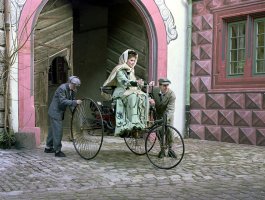
Mercedes-Benz is the only car brand to carry a female name and has done so for 120 years.
Have you ever wondered how did Mercedes-Benz get its name? For over 120 years, the Mercedes name was spoken and referred to countless times, whether in admiration or vain, appearing in movies or mentioned in song titles and lyrics sung in a dozen languages.
It is the name we keep telling ourselves that one day will be the car we call our own. And we flew the flag in some way or another, whether we are passionate about the brand or rooting for our favourite F1 or endurance sportscar racing teams. But, had we stop and wondered how Mercedes-Benz got its Spanish name?
It all began 120 years ago. On April 2, 1900, Daimler-Motoren-Gesellschaft (DMG) decided to call its automobiles Mercédès, after the daughter of a wealthy Austro-Hungarian Businessman and diplomat Emil Jellinek.

As an avid fan for the DMG brand, Jellinek had signed up two DMG-Phoenix cars for competing in the Nice-La Turbie race on 30 March 1900, introducing the Mercedes name for both his racing team and its cars. However, a tragedy happened when Wilhelm Bauer, the chief mechanic of DMG was killed at the first curve of the race. Consequently, DMG called off all further involvement in racing.
Nevertheless, Jellinek convinced DMG to design a new car to compete again. This time he insisted that a more powerful engine is needed and should be developed by Maybach and Paul Daimler. Jellinek specified radical changes to the new car: the new race car should be longer, wider, and have a lower centre of gravity with the 35 hp 5,918 cc engine mounted closer to the ground. Also, it would have a lighter steel body and stronger chassis.
 In addition, the new engine featured Bosch’s ignition magneto electric ignition system, which paved the company’s way to be the leading automotive supplier.
In addition, the new engine featured Bosch’s ignition magneto electric ignition system, which paved the company’s way to be the leading automotive supplier.
Then In March 1901, the Mercedes car returned to racing and caused quite a stir at the Nice race week. Not only because of its groundbreaking design, but the Mercedes 35 hp also dominated the competition in all capacity classes. The Mercedes 35 hp was so advanced that it was the bleeding edge of cars and regarded as the prototype of the modern automobile. Paul Meyan, then Secretary-General of the Automobile Club of France, said after the race week: “We have entered the Mercedes era.”
And from then on, the cursive “Mercédès” lettering adorned the radiators of Daimler passenger cars. The name was registered as a trademark on June 23, 1902, and legally protected on September 26, 1902. Since then, the name was changed to Mercedes-Benz, after the merger of Daimler and Benz in June 1926.
The only car brand with a female name

It is not only the name, but it is the women who shaped the success story of Mercedes-Benz from the start.
In August 1888, Bertha Benz drove from Mannheim to Pforzheim with her two sons in the Patent Motor Car built by her husband Carl Benz. A few days later, she returned to Mannheim. This first long-distance trip was a pioneering undertaking.
For the most part, it all ran smoothly: there were only a few minor technical problems on the route, which were all solved along the journey and helped to improve the Benz Patent Motor Car’s roadworthiness. Technically this made Bertha Benz the world’s first development test driver.
By completing the first long-distance journey in automotive history, Bertha Benz not only proved to her husband, as she planned but also to many the sceptics that the automobile had a big future ahead. She had demonstrated that the motor car was fit for purpose on the 180-kilometre journey to and from.
And, the rise of the later Benz & Cie. Rheinische Gasmotorenfabrik AG, Mannheim, to become the biggest automotive factory in the world would barely have been imaginable had it not been for her daringness – and that of her sons. Recently, Mercedes-Benz commissioned a dramatised short film to commemorate their journey.
Moreover, Mercedes-Benz recognises that are more women buying cars these days. The luxury automaker’s She’s Mercedes initiative is a platform dedicated to inspiring, connecting and empowering women, highlighting their unique success and creating a dialogue that transcends cultures, industries and experiences.
Women like Mercédès Jellinek or Bertha Benz shaped the success story of Mercedes-Benz from the start, with our She’s Mercedes initiative, founded in 2015, we are building on this tradition for our numerous female customers around the world. The future of Mercedes-Benz will combine sustainability and luxury in a fascinating way.
Bettina Fetzer, head of Marketing Mercedes-Benz AG

